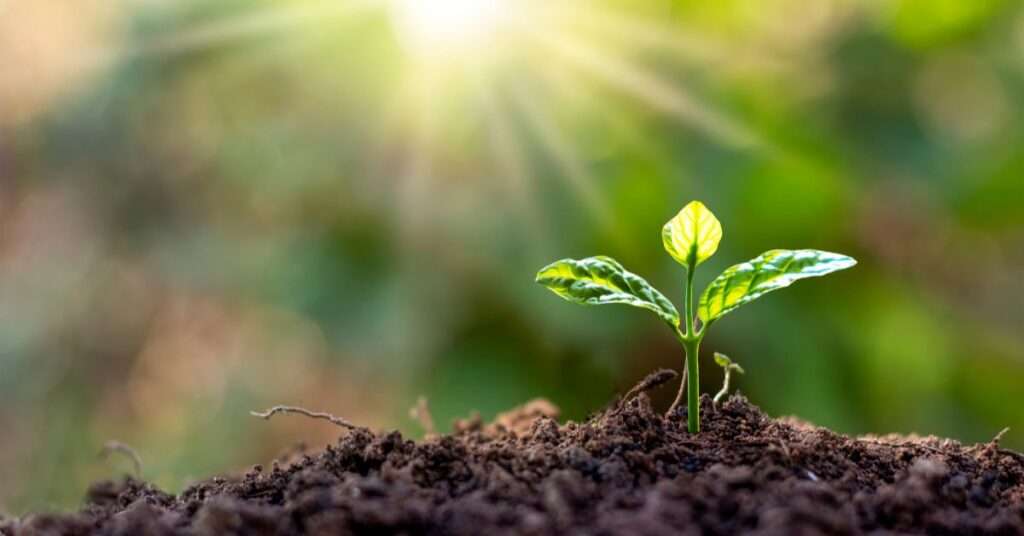I had the opportunity to be in Dallas, TX a few weeks ago to witness the total solar eclipse. Though heavy cloud coverage threatened to obscure the whole thing, thankfully, the clouds parted about an hour before first contact and the sky remained clear throughout the eclipse event. And it was even more incredible than I ever thought it would be!
One thing that really stood out to me during the eclipse though was how truly powerful our sun is. The tiniest sliver of sun exposed behind the moon was still too bright to see without special viewing glasses. While the colors of things were definitely muted and the temperature was cooler, that tiny slice of sun still lit up everything around us.
The power of the sun is overwhelming, yet it is precisely what it needs to be for life to exist here on earth. Its gravity, even at the distance of 93 million miles away, holds our planet in orbit. And from that distance, it radiates light and heat to warm the earth so that it doesn’t freeze. It generates winds, ocean currents, and clouds which allow the water cycle to operate. Ultimately, because of its light and energy, the sun is responsible for life existing here.
All organisms require energy in order to function, but in accordance with the First Law of Thermodynamics, energy cannot just appear or disappear. It must be converted from the amount of energy that already exists in the universe (an interesting question here would be, “Where did that amount of energy come from?”). Most organisms, those that are not plants, must get their energy from an outside source. Plants, however, have the unique ability to create their own energy.
Through the process of photosynthesis, plants can take light energy from the sun, along with water and carbon dioxide, and turn it into chemical energy which produces sugar and oxygen. It is through this system that life on this planet is uniquely sustainable. Plants produce energy and oxygen for other living organisms; and those organisms in turn provide carbon dioxide for the plants.
How are plants able to do this function that is critical to the survival of every living thing on earth? The process of photosynthesis includes multiple components within the plant cells that work in an integrated fashion. Plants first require specific components within the cell in order to absorb the energy from light to initiate the whole process.
However, there are specific characteristics about light that are necessary for photosynthesis to work. Light has actually been a bit of a mystery to scientists. According to Encyclopedia Britannica, light was originally defined with the wave theory, where light was described as electric and magnetic fields traveling through space like a wave.
But that failed to fully explain the behavior of light at the atomic level. Therefore, a quantum theory was used to describe the interaction of light with atoms and molecules. Quantum theory defines light as discrete packets of energy known as photons. Neither theory fully describes light because light is both a particle and a wave. As a result, in the mid-20th century, a third theory, quantum electrodynamics (QED), was developed to accommodate both of these aspects of light.
What does this have to do with photosynthesis? Without both of these properties of light, photosynthesis could not work. Light travels through space as a wave but interacts inside the plant cell as a discrete packet of energy, enabling plants to generate energy and oxygen which sustains all life. If light did not have these properties, plants could not perform photosynthesis. The sun has been perfectly designed with its level of light and energy output, with its position in relation to the earth, and with its stability for life to thrive on earth.
So what happens when that light gets inside the plant cell? Photosynthesis occurs inside of the chloroplast, something unique to the plant cell. Within the chloroplasts are special regions specifically designed to absorb light. The photosynthesis process is broken into two cycles: the light-dependent reactions, which uses light and water to produce ATP, NADPH, and oxygen; and the Calvin cycle, which uses the ATP and NADPH along with carbon dioxide to produce sugar.
The light-dependent cycle has two phases, but both phases work by passing along energized electrons. The only way these electrons can get energized though is by the absorption of energy from light, an ability found only in plants, algae, and cyanobacteria. Animals and humans can stand in this sunlight all day, but we are still unable to produce our own energy from the sun. In other words, if there were not special receptors within plants to absorb light energy – receptors that plants have – life could not exist. These receptors are so specifically designed for this that they are even referred to as “special pairs.” That is the actual scientific name for them.
A recent 3D modeling project produced by a secular university to depict photosynthesis even described these as “uniquely designed to capture light” yet then proceeded to claim plants have allowed millions of years of evolution of life. If the plant cell’s chloroplasts have been specially designed for this function and require multiple well-matched and integrated components to complete photosynthesis, then plants must have been specifically designed this way by something intelligent. A natural process of evolution cannot account for the mechanism of photosynthesis.
Furthermore, there are actually two different chlorophyll special pairs, each absorbing light at a different wavelength, one at 680 nm and one at 700 nm. When the light photon hits the first special pair (called P680 because that is the wavelength of light it absorbs), it energizes an electron and then passes it through to the next special pair, P700 (also named for the wavelength of light it absorbs). These energized electrons are used to form NADPH. The NADPH provides electrons for the production of ATP which, as study.com states, produces the “carbohydrates essential for all life on Earth.”
What is fascinating is the light-dependent reactions require a large supply of electrons to complete this process. The plants get that source of electrons from water molecules (yet another cyclical, self-sustaining resource on earth). Because the plant takes electrons from water molecules as opposed to some other compound, the plant is able to produce oxygen which, again, is responsible for sustaining all other life forms on earth.
Furthermore, taking electrons from a water molecule also produces hydrogen ions. These hydrogen ions are used to convert ADP into ATP, which is used in the next cycle (the Calvin cycle) to produce sugar. Sugar is a carbon-based substance though, so where are the plants going to get carbon? From the carbon dioxide that animals and humans exhale. However, once again, plants need a specific feature to enable it to intake carbon dioxide. The plant leaves and stems have a pore, or opening, known as the stomata, that allows gas exchange between the plant and the atmosphere. Guard cells around the stomata regulate the size of the opening as it allows carbon dioxide to enter the plant and oxygen to exit.
Notice the hundreds of special features and components within the plant that enable it to produce the oxygen and energy that all other life forms require. But there are things outside of the plant that are necessary for photosynthesis to work as well, like water and sunlight. The fact that each step of photosynthesis is a part of a larger self-sustaining cycle indicates there was a thoughtful planning to how the earth’s energy supply would work. Through photosynthesis alone, we see the impact of the water cycle, the carbon cycle, the nitrogen cycle, and the phosphorous cycle. The earth was engineered to sustain itself, which indicates it was designed by intelligence.
Rather than see the mechanism of photosynthesis as designed by our Creator, evolutionists will claim that these special structures evolved out of cyanobacteria. Cyanobacteria are unicellular organisms (not plants) that can also perform photosynthesis. They don’t have chloroplasts, but they can convert light energy into chemical energy using photosynthetic pigments, such as chlorophyll a, xanthophylls, and phycobilin. Evolutionists claim this was the ancestor and precursor to the chloroplasts in plants. They say the plant cells “swallowed up” the chlorophyll in the cyanobacteria to develop its own method of photosynthesis.
However, this explanation fails on numerous levels. It fails to explain the existence of the photosynthetic pigments in the first place. Even if the cyanobacteria do not use the chloroplast structure of plants for photosynthesis, chlorophyll are still specifically designed to absorb light to energize electrons and convert light energy into chemical energy for the cell. This is still a highly complex process whose existence requires some explanation. There is no intermediate step between no photosynthesis to full photosynthesis that would show the cyanobacteria gradually built up to the ability to synthesize its own food source.
There is also no explanation as to how or why a plant cell would have “swallowed up” the cyanobacteria cells in order to gain the ability to perform photosynthesis. And even if the plant cells did this, that does not result in the formation of a chloroplast. It would simply use the same process the cyanobacteria use instead of developing a new process with a new complex structure. The evolutionist explanation would need to give some detail as to how and by what steps the chloroplast could form.
The better explanation is that God designed these organisms to be able to synthesize energy and oxygen from light and carbon dioxide. The specialized features and structures used in this process, along with the properties of light and the existence of water, carbon dioxide, phosphorous, ADP, NADPH, and numerous other structures, show the beautiful design God used to have a planet that can sustain life.





1 thought on “How Do Plants Do That?”
Wow!!! What a great God we have. I think the energy required to reject a great uncaused and sustaining Cause of all things, seen and unseen, (a great Designer) should be calculated and captured.
Comments are closed.